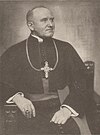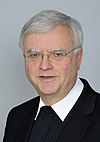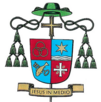List of the bishops of Dresden-Meißen
The medieval diocese of Meissen extended beyond the Upper Saxon core area of the margraviate of Meissen into Lusatia , so that when the Reformation was introduced in the Albertine duchy of Saxony in 1539, Catholic areas continued to exist. This list includes the bishops of the Meissen diocese up to the Reformation, the Apostolic Prefects of Meissen subsequently appointed for Lusatia, the Apostolic Vicars in the Saxon Hereditary Lands since the Saxon-Polish period, and the bishops of the Meissen diocese , re-established in 1921 , since 1979 Diocese of Dresden- Meissen . The auxiliary bishops in Meissen are not listed here .
The bishops in the Middle Ages and the early modern period
The following list gives a succession of the bishops of the Roman Catholic diocese of Meissen .
| No. | bishop | from | to | description | presentation | coat of arms |
|---|---|---|---|---|---|---|
| 1 | Burchard | 968 | 969 | |||
| 2 | Volkold | 969 | 992 | |||
| 3 | Eido I. | 992 | 1015 | Eido was a contemporary of Bishop Thietmar von Merseburg . | ||
| 4th | Eilward | 1016 | 1023 | Eilward was appointed by Emperor Heinrich II . During his time as bishop Hermann I was Margrave of Meissen. | ||
| 5 | Hugbert | 1023 | 1024 | Like his successor, Hugbert was ordained bishop by the Magdeburg Metropolitan Humfried . | ||
| 6th | Dietrich I. | 1024 | 1040 | Dietrich I was the founder of the St. Afra Church . He took part in the Synod of Frankfurt convened by Konrad II in 1027 . Meißen and Lausitz became a theater of war between the emperor and Mieszko II. Lambert . The emperor destroyed temples and idols of the Wends and excluded those who did not want to profess the Christian faith from privileged positions. | ||
| 7th | Eido II | 1040 | 1046 | Eido II appears in documents only as part of a donation from Emperor Heinrich III. to the Meißner Hochstift, which was suggested by the intercession of the Archbishop of Magdeburg Humfried and the Meißen Margrave Ekkehard I. | ||
| Meinward | Older rows of bishops list a bishop Meinward for the period from 1046 to 1051 at this point . But it is a historically incorrect assignment of Bishop Reinward (1140–1150). | |||||
| 8th | Bruno I. | 1046 | 1065 | The existence of Bruno I is reliably proven by - only - three deeds of gift. Margrave of Meissen was to 1062 Wilhelm , the Otto I succeeded. | ||
| 9 | Purer | 1065 | 1066 | Reiner was consecrated by the Magdeburg Metropolitan Werner von Steusslingen . He was active as a bishop for only two years. | ||
| Craft | 1066 | 1066 | Craft was provost in Goslar . The Kaiserpfalz Goslar with the Goslar Cathedral or the Goslar Pen had reached a heyday. Craft was elected bishop and received ordination. However, he died before his return to Meissen. | |||
| 10 | St. Benno | 1066 | 1106 |

|
||
| 11 | Herwig | 1106 | 1119 | Herwig is said to have been born in Wurzen in Gau Siusili , where he also founded the Wurzen collegiate monastery and was buried there. In 1119 a crusade began against the Sorbs , which had obviously been preceded by bitter disputes in the border region. | ||
| Grambert | Older ranks of bishops list a bishop Grambert for the period from 1118/1119 to 1125 at this point . But it is a historically incorrect assignment of Bishop Reinward (1140–1150). | |||||
| 12 | Godebold | 1119 | 1140 | Godebold was enthroned by the Magdeburg Metropolitan Rudgar von Veltheim . Godebold had a friendly relationship with his successor, Saint Norbert von Xanten . At a diocesan synod held in 1130, the Margrave Conrad I was present with his sons Otto , Dietrich , Heinrich , Dedo and Friedrich . | ||
| 13 | Reinward | 1140 | 1150 | Reinward was first provost of the cathedral in Meissen. He experienced the Second Crusade . | ||
| Berthold | Older rows of bishops list a bishop Berthold for the period from 1146 to 1149/50 at this point . But such a bishop cannot be proven. | |||||
| 14th | Albrecht I. | 1150 | 1152 | Albrecht I is said to come from the Sorbian nobility. The contemporary historian and Freising Bishop Otto mentions him in connection with the dispute between Friedrich von Berg and Hermann von Horn over the bishopric in Utrecht. With the consent of the Pope, the diocese came under the protection of Margrave Konrad von Meissen . Just like the diocese of Naumburg , taxes and other claims were accepted in return. In 1152 the Roman-German King Conrad III. the bishop, who was known to be eloquent, on a diplomatic mission to the Greek emperor Manuel I. The bishop died on the way there or at his destination in Constantinople . | ||
| Bruno II | Older ranks of bishops list a bishop Bruno II at this point , and, according to a different count, also Bruno I for the period from 1152 to 1154. But such a bishop cannot be proven. The cause of the error is evidently an incorrect dating of Bruno I (1046-1065). | |||||
| 15th | Gerung | 1152 | 1170 | Gerung settled immigrant Flemish farmers in Kühren and provided them with some privileges. Duke Vladislav II invaded the country due to border disputes with the margraviate of Meissen and wreaked havoc. | ||
| 16 | Martin | 1170 | 1190 | Martin was among the participants in the Third Lateran Council . The establishment of the Altzella monastery falls during his time as bishop. He died on the Third Crusade near the city of Tire . | ||
| 17th | Dietrich II of Kittlitz | 1191 | 1208 |

|
||
| 18th | Bruno II of Porstendorf | 1209 | 1228 | |||
| 19th | Heinrich | 1228 | 1240 | |||
| 20th | Konrad I. von Wallhausen | 1240 | 1258 | |||
| 21st | Albrecht II of Mutzschen | 1258 | 1266 | see also Mutzschen | ||
| 22nd | Withego I of Furra | 1266 | 1293 | |||
| 23 | Bernhard von Kamenz | 1293 | 1296 | |||
| 24 | Albrecht III. from Leisnig | 1296 | 1312 | Albrecht III. came from the castle counts of the Leisnig family . | ||
| 25th | Withego II of Colditz | 1312 | 1342 | see also Colditz (noble family) | ||
| 26th | Johann I of Isenburg | 1342 | 1370 | |||
| Dietrich von Schönberg | 1370 | 1370 | Dietrich von Schönberg was elected bishop in 1370. However, this choice was initially not recognized in Rome. Dietrich died on the return journey from Rome after he had obtained confirmation of his election from Pope Urban V. |

|
||
| 27 | Konrad II of Kirchberg-Wallhausen | 1370 | 1375 | |||
| 28 | Johann II of Jenstein | 1375 | 1379 | |||
| 29 | Nicholas I. | 1379 | 1392 | |||
| 30th | Johann III. from Kittlitz | 1392 | 1398 | Johann III. came from the von Kittlitz family . He was previously Bishop of Lebus (1382-1392). Due to his age, he gave up in 1398 and died in 1408. |

|
|
| 31 | Thimo from Colditz | 1399 | 1410 | see also Colditz (noble family) | ||
| 32 | Rudolf von der Planitz | 1411 | 1427 |

|
||
| 33 | Johannes IV Hoffmann von Schweidnitz | 1427 | 1451 | |||
| 34 | Caspar von Schönberg | 1451 | 1463 |

|
||
| 35 | Dietrich III. from Schönberg | 1463 | 1476 |

|
||
| 36 | Johann V. von Weißenbach | 1476 | 1487 | Johann V was a contemporary of Melchior von Meckau , who was provost of Meissen in 1482. |

|
|
| 37 | Johann VI. from Saalhausen | 1487 | 1518 | see also Saalhausen (noble family) |
 
|
|
| 38 | Johann VII von Schleinitz | 1518 | 1537 | see also Schleinitz (noble family) |

|
|
| 39 | Johann VIII von Maltitz | 1537 | 1549 | see also Maltitz (noble family) |

|
|
| 40 | Nicolaus II von Carlowitz | 1550 | 1555 | see also Carlowitz (noble family) |

|
|
| 41 | Johann IX. from Haugwitz | 1555 | 1559/81 | Johann IX. came from the von Haugwitz family . He was the last bishop of the diocese of Meissen, which became Protestant during the Reformation . In 1559 he appointed Johann Leisentrit as administrator of the remaining Catholic areas. In 1581 he gave up his office as bishop, switched to Protestantism himself and married a year later. He died in 1595. |

|
Apostolic Prefect of Meissen
Since there was no sovereign present as an imperial fiefdom in the two Lusatia and the principle " Cuius regio, eius religio " therefore applied to the respective territorial lords , the Catholic denomination was able to hold here in some areas. Bishop Johann IX. had appointed Johann Leisentritt as diocesan administrator for the areas of Lusatia with his seat in Bautzen in 1560 for the diocesan area outside Saxony. In 1567 the Holy See established the Apostolic Prefecture of Meissen for the Diocesan area of Meißen in 1567 with Leisentritt as prefect. An Apostolic Prefect is the holder of a diocese on probation.
After its seat or location, the prefecture was also called the Apostolic Prefecture of Bautzen or Apostolic Prefecture of Lusatia, and after the Prussian annexation of Lower Lusatia and eastern Upper Lusatia, it was also called the Apostolic Prefecture of the (Saxon) Upper Lusatia. The prefecture for the (Upper) Lausanne areas of the former diocese of Meißen was held by the dean of Bautzen, whose episcopal function was mostly underlined by ordination as titular bishop from the 19th century .
The Apostolic Vicars in the Saxon Hereditary Lands
In 1708, the confessor of the Saxon Elector Friedrich August I , Karl Moritz Vota (SJ) was appointed "Apostolic Prefect" of the "Mission in Dresden and all of Saxony" for five years . It is uncertain whether these rights were extended, but he appears to have exercised them until his death in 1715.
As a result, the Catholics in Saxony came under the jurisdiction of the Apostolic Vicar of the Nordic Missions or the Cologne Nuncio . There are no documents on the formal establishment of an Apostolic Vicariate for Saxony, but one can be assumed.
| Surname | from | to |
|---|---|---|
| Ludwig Li (e) geritz , SJ | 1743 | 1749 |
| Leo Rauch , SJ | 1749 | 1763 |
| Augustin Eggs , SJ | 1763 | 1764 |
| Franz Herz , SJ | 1764 | 1800 |
| Johann Aloys Schneider | 1801 | 1818 |
| Ignaz Bernhard Mauermann | 1819 | 1841 |
| Franz Laurenz Mauermann | 1841 | 1845 |
| Joseph Dittrich | 1846 | 1853 |
| Ludwig Forwerk | 1854 | 1875 |
| Franz Bernert | 1875 | 1890 |
| Ludwig Wahl | 1890 | 1900 |
| Carl Maaz (Apostolic Provicer ) | 1900 | 1903 |
| Georg Wuschanski | 1903 | 1905 |
| Aloys Schaefer | 1906 | 1914 |
| Franz Löbmann | 1914 | 1920 |
| Jakub Skala (administrator) | 1920 | 1921 |
The bishops of modern times
On November 15, 1979, the name of the diocese of Meissen was changed to Dresden-Meissen . The following year, on March 25, 1980, Bishop Gerhard Schaffran moved the bishopric to Dresden. Bishops of Meißen and Dresden-Meißen were (since the re-establishment on June 26, 1921) and are in the scope of the areas of the previous Apostolic Prefecture Saxon Upper Lusatia and the Apostolic Vicariate of Saxony including Saxony-Altenburg and the two Russian principalities in Thuringia .
| Surname | from | to | image | coat of arms |
|---|---|---|---|---|
| Christian Schreiber | September 18, 1921 | August 31, 1930 |

|

|
| Conrad Groeber | February 15, 1931 | May 21, 1932 | ||
| Petrus Legge | October 28, 1932 | March 9, 1951 |

|
|
| Heinrich Wienken | March 9, 1951 | August 21, 1957 | ||
| Otto Spülbeck | June 20, 1958 | June 21, 1970 |

|
|
| Gerhard Schaffran | September 21, 1970 | July 31, 1987 |

|
|
| Joachim Reinelt | 20th of February 1988 | February 20, 2012 |

|
|
| Heiner Koch | March 16, 2013 | June 8, 2015 |

|
|
| Heinrich Timmerevers | August 27, 2016 |

|
literature
- Ernst Gotthelf Gersdorf : Document book of the Meissen Monastery . In: Codex diplomaticus Saxoniae regiae . Leipzig 1864-1867.
- Thomas Ludwig: The documents of the bishops of Meißen. Diplomatic investigations on the 10th – 13th Century. Cologne 2008, ISBN 978-3-412-25905-1 review
- Ernst Friedrich Mooyer: Directories of the German bishops since the year 800 AD. Geb. Minden 1854. P. 64–65 .
- Eduard Machatschek : History of the bishops of the Meissen Monastery in chronological order (...) . Dresden 1884. ( digitized version )
- Heinrich Meier: The Apostolic Vicariate in the Saxon hereditary lands. (Studies on the history of the Catholic diocese and monastery 24). Leipzig 1981.
- Siegfried Seifert: Diocese of Meissen. In: Erwin Gatz (ed.): The dioceses of the Holy Roman Empire . Freiburg 2003. ISBN 3-451-28075-2 . Pp. 427-436.
Web links
Remarks
- ↑ Entry on Diocese of Dresden-Meissen: Historical Details on catholic-hierarchy.org ; Retrieved July 25, 2016.




